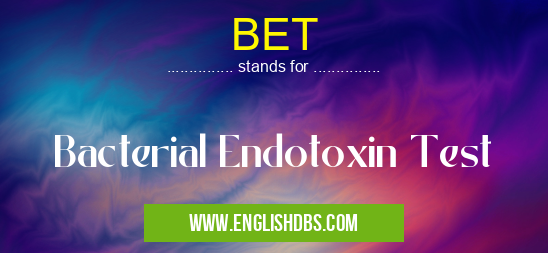What does BET mean in UNCLASSIFIED
Bacterial Endotoxin Test (BET) is a biological assay designed to detect and quantify bacterial endotoxins in various samples. Endotoxins, also known as lipopolysaccharides (LPS), are components of the outer membrane of Gram-negative bacteria. These substances can trigger strong immune responses and are responsible for various clinical symptoms associated with bacterial infections.

BET meaning in Unclassified in Miscellaneous
BET mostly used in an acronym Unclassified in Category Miscellaneous that means Bacterial Endotoxin Test
Shorthand: BET,
Full Form: Bacterial Endotoxin Test
For more information of "Bacterial Endotoxin Test", see the section below.
Introduction to BET
Mechanism of BET
BET utilizes lysate derived from Limulus polyphemus, the horseshoe crab. When endotoxins interact with the lysate, they activate a cascade of reactions leading to the formation of a gel clot. The time taken for clot formation is inversely proportional to the endotoxin concentration in the sample. This reaction is highly specific for endotoxins, making BET a reliable method for their detection.
Applications of BET
BET is widely used in various industries and applications, including:
- Pharmaceutical manufacturing: To ensure the absence of endotoxins in injectables, vaccines, and other drug products.
- Medical device manufacturing: To test the endotoxin levels in medical implants, catheters, and surgical instruments.
- Water and food testing: To monitor endotoxin contamination in drinking water, food products, and cosmetics.
- Environmental monitoring: To detect endotoxins in air and surface samples in healthcare settings or industrial environments.
Conclusion
BET is an essential tool for ensuring the safety and purity of products and environments by detecting and quantifying bacterial endotoxins. Its high specificity, sensitivity, and versatility make it a valuable method for various industries, including pharmaceutical, medical device, and environmental monitoring.
Essential Questions and Answers on Bacterial Endotoxin Test in "MISCELLANEOUS»UNFILED"
What is the Bacterial Endotoxin Test (BET)?
The Bacterial Endotoxin Test (BET) is a laboratory test used to detect the presence of bacterial endotoxins in a sample. Endotoxins are components of the outer membrane of Gram-negative bacteria, and their presence in a product can cause fever, chills, and inflammation in humans. BET is essential for ensuring the safety of injectable drugs, medical devices, and other products that come into contact with the human body.
How does the BET work?
BET involves adding a sample to a solution containing horseshoe crab blood cells. If endotoxins are present, they will interact with a protein in the blood cells, causing them to clot. The amount of clotting is proportional to the concentration of endotoxins in the sample. The test results are reported in endotoxin units (EU) per milliliter (mL).
What is the sensitivity of the BET?
The BET is highly sensitive, able to detect endotoxin concentrations as low as 0.05 EU/mL. This makes it suitable for testing products that are intended to be free of endotoxins, such as injectable drugs and medical devices.
How long does the BET take?
The BET typically takes 1-2 hours to complete. This includes the time for the sample to react with the horseshoe crab blood cells and for the clotting to occur.
What are the limitations of the BET?
The BET is not specific for endotoxins from Gram-negative bacteria. It can also react with other substances, such as glucans and some types of fungi. This can lead to false positive results. Additionally, the BET is not suitable for testing products that contain high levels of protein or lipids, as these can interfere with the test.
BET also stands for: |
|
| All stands for BET |
